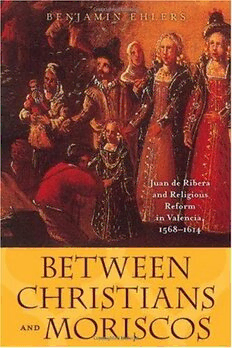
Between Christians and Moriscos: Juan de Ribera and Religious Reform in Valencia, 1568–1614 PDF
Preview Between Christians and Moriscos: Juan de Ribera and Religious Reform in Valencia, 1568–1614
The Johns Hopkins University Studies in Historical and Political Science 124th series (2006) 1.benjamin ehlers, Between Christians and Moriscos: Juan de Ribera and Religious Reform in Valencia, 1568–1614 2.eric r dursteler, Venetians in Constantinople: Nation, Identity, and Coexistence in the Early Modern Mediterranean Between Christians and Moriscos Juan de Ribera and Religious Reform in Valencia, 1568–1614 benjamin ehlers The Johns Hopkins University Press Baltimore This book has been brought to publication with the generous assistance of the Program for Cultural Cooperation between Spain’s Ministry of Culture and United States Universities. © 2006 The Johns Hopkins University Press All rights reserved. Published 2006 Printed in the United States of America on acid-free paper 2 4 6 8 9 7 5 3 1 The Johns Hopkins University Press 2715 North Charles Street Baltimore, Maryland 21218-4363 www.press.jhu.edu Library of Congress Cataloging-in-Publication Data Ehlers, Benjamin. Between Christians and Moriscos : Juan de Ribera and religious reform in Valencia, 1568–1614 /Benjamin Ehlers. p. cm. Includes bibliographical references (p. ) and index. isbn0-8018-8322-9 (hardcover : alk. paper) 1. Juan de Ribera, Saint, 1532–1611. 2. Valencia (Spain)—Church history. 3. Moriscos—Spain—Valencia. I. Title. bx4700.j739e35 2006 261.2(cid:1)7(cid:1)0946763—dc22 2005021648 A catalog record for this book is available from the British Library. Frontispiece:Pere Oromig, Embarque de los Moriscos en el Grau de Valencia (1612–13). Colección Bancaja, Valencia, Spain. At the moment of his exile from Valencia, a kneeling morisco father bids farewell to his daughter, who has been adopted by an Old Christian family. Detail from Pere Oromig, Departure of the Moriscos from the Port of Valencia (1612–13). La Expulsión de los Moriscos del reino de Valencia, 51–53. Valencia: Fundación Bancaja, 1997. Photographed by Juan García Rosell and Gil Carles. To my family This page intentionally left blank Contents Preface ix Acknowledgments xv Prologue. The Formation of a Tridentine Bishop 1 1 Two Flocks, One Shepherd: Christians and Muslims in Valencia 9 2 The Limits of Episcopal Authority: The Pasquinades of 1570–1571 36 3 Reform by Other Means: The Colegio de Corpus Christi 58 4 From Moriscos to Moros: Ribera and the Baptized Muslims of Valencia 80 5 Disillusionment and Its Consequences: Ribera, Philip II, and the Valencian Moriscos 106 6 Justifying the Expulsion: Ribera and Philip III 126 Conclusion. The Ideal Bishop and the End of Spanish Islam 151 Notes 159 Bibliography 215 Index 237 Illustrations appear following page 79 This page intentionally left blank Preface In February 1610, the archbishop of Valencia, Juan de Ribera, petitioned King Philip III to close the schools in the capital city dedicated to educating the children of moriscos, or baptized Muslims, in the Christian faith. Founded nearly a hundred years earlier, these schools represented the hope that the children among this reli- gious minority could be induced to lead Christian lives despite the widespread sur- vival of Islamic practices among their parents. Early in his tenure as archbishop (1568–1611), Juan de Ribera had demonstrated his belief in the possibility of con- version by supporting these schools and reorganizing the parish system to place priests in morisco areas throughout the diocese. Over time, however, Ribera de- spaired of these projects and came to advocate instead the wholesale expulsion of Spain’s three hundred thousand moriscos to North Africa, an event that came about in 1609–14. His request of 1610 emerged from the ensuing debate over the fate of the morisco children. Doubting that even four-year-olds separated from their parents and immersed in Spanish society could be truly remade as Christians, Ribera at- tempted to at least free himself of this financial burden by asking that all the chil- dren from the morisco schools be placed in private homes.1 His cynicism on this score in his last years of life reflected his belief that only total expulsion could free Spain of any lingering morisco practices. Ribera had another motive as well: closing the schools would allow him to divert their rents to his prized foundation in the city of Valencia, the seminary and chapel he christened the Colegio de Corpus Christi. Ribera’s relationship with the Catholic majority in his diocese followed a very different trajectory from his increasing hos- tility toward the moriscos. The so-called Old Christians, who claimed to be un- tainted by Jewish or Moorish blood, distinguished themselves from the baptized de- scendants of these other faiths, whom they referred to as New Christians. After stumbling through an initial series of obstacles in the capital city, Ribera caught his stride among the Old Christian community, modifying his program of reform to ac- commodate the religious impulses of the Valencian laity. Through his patronage of
